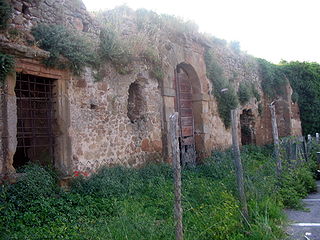 W
WAn agger (Latin) is an ancient Roman embankment or any artificial elevation.
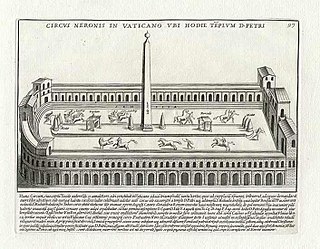 W
WPietro Santi Bartoli was an Italian engraver, draughtsman and painter.
 W
WThe Bierzo Edict, also referred to as the Edict of Augustus from El Bierzo and the Bembibre Bronze is a controversial document dated to 15 BCE found in El Bierzo in Spain in 1000. The document is a bronze tablet measuring 24.15 cm x 15.6 cm. At the top it has a moulded 3 cm ring.
 W
WThe Bridgeness Slab is a Roman distance slab created around 142 CE marking a portion of the Antonine Wall built by the Second Legion. It is regarded as the most detailed and best preserved of the Scottish distance slabs. The sandstone tablet was found at Bridgeness in Bo'ness, Scotland in 1868 on a promontory close to Harbour Road. The original is in the National Museum of Scotland in Edinburgh, while a replica is near the site of its discovery.
 W
WLucius Caecilius Iucundus was a banker who lived in the Roman town of Pompeii around 14 A.D.–79 A.D. His house still stands and can be seen in the ruins of the city of Pompeii which remain after being partially destroyed by the eruption of Vesuvius in 79 AD. This house is known for its beauty, along with some material found about bank book-keeping and wax tablets, which were receipts. He is well known for being a central character in the Cambridge Latin Course series.
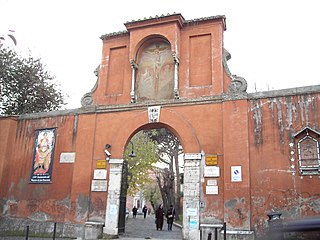 W
WThe Catacomb of San Pancrazio is a catacomb of Rome (Italy), located in the Via Aurelia, within the modern Quartiere Gianicolense.
 W
WCatherine Downes was an English antiquarian and archaeologist, who excavated a Roman villa near Warminster, Wiltshire, in 1786. Downes is a significant figure in the early history of archaeology, since she was one of the first women antiquarians to excavate a Roman site; the other was Frances Stackhouse Acton. Downes is also one of the earliest recorded women who contributed to the work of the Society of Antiquaries of London.
 W
WSecondina Lorenza Eugenia Cesano was an Italian numismatist and professor of numismatics at the Sapienza University of Rome.
 W
W39 Bridge Street is a building in Chester, Cheshire, England. It is recorded in the National Heritage List for England as a designated Grade I listed building, its major archaeological feature being the remains of a Roman hypocaust in its cellar.
 W
WThe Chichester inscription, Chichester stone or Pudens stone is an inscription on a damaged slab of marble, found in Chichester in 1723 and datable to the late 1st century.
 W
WThe Circus Maximus is an ancient Roman chariot-racing stadium and mass entertainment venue in Rome, Italy. In the valley between the Aventine and Palatine hills, it was the first and largest stadium in ancient Rome and its later Empire. It measured 621 m (2,037 ft) in length and 118 m (387 ft) in width and could accommodate over 150,000 spectators. In its fully developed form, it became the model for circuses throughout the Roman Empire. The site is now a public park.
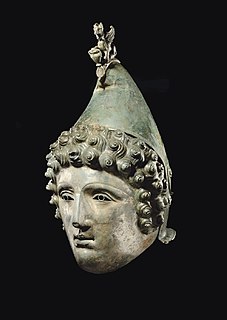 W
WThe Crosby Garrett Helmet is a copper alloy Roman cavalry helmet dating from the late 2nd or early 3rd century AD. It was found by an unnamed metal detectorist near Crosby Garrett in Cumbria, England, in May 2010. Later investigations found that a Romano-British farming settlement had occupied the site where the helmet was discovered, which was located a few miles away from a Roman road and a Roman army fort. It is possible that the owner of the helmet was a local inhabitant who had served with the Roman cavalry.
 W
WDağlı Castle is a castle ruin in Mersin Province, Turkey
 W
WThe Duenos inscription is one of the earliest known Old Latin texts, variously dated from the 7th to the 5th century BC. It is inscribed on the sides of a kernos, in this case a trio of small globular vases adjoined by three clay struts. It was found by Heinrich Dressel in 1880 in the valley between Quirinale and Viminale in Rome. The kernos is part of the collection of the Staatliche Museen in Berlin.
 W
WThe Colosseum is an oval amphitheatre in the centre of the city of Rome, Italy, just east of the Roman Forum. It is the largest ancient amphitheatre ever built, and is still the largest standing amphitheatre in the world today, despite its age. Construction began under the emperor Vespasian in 72 and was completed in 80 AD under his successor and heir, Titus. Further modifications were made during the reign of Domitian. The three emperors that were patrons of the work are known as the Flavian dynasty, and the amphitheatre was named the Flavian Amphitheatre by later classicists and archaeologists for its association with their family name (Flavius).
 W
WForum Hadriani, in the modern town of Voorburg, was the northernmost Roman city on the European continent and the second oldest city of the Netherlands. It was located in the Roman province Germania Inferior and is mentioned on the Tabula Peutingeriana, a Roman road map.
 W
WThe Bishop's Basilica of Philippopolis, also known as the Great Basilica, is a ruined church from the ancient city of Philippopolis in Plovdiv and built in the mid-4th century AD. It is the largest late antique early-Christian church discovered in Bulgaria and one of the largest from that period on the Balkans. Its architecture was remarkable. It included a central and two side naves, an apse, a narthex (anteroom), and a colonnaded atrium. A marble-decorated presbyterium rose in the central nave.
 W
WThe Guisborough Helmet is a Roman cavalry bronze helmet found in 1864 near Guisborough in the North Riding of Yorkshire, England. It was originally fitted with a pair of protective cheek-pieces, which have not survived; the holes by which they were attached can be seen in front of the helmet's ear guards. It is lavishly decorated with incised, punched and embossed figures, indicating that it was probably used for displays or cavalry tournaments, though it may well have been intended to be worn in battle as well. The helmet was found in what appears to have been a carefully arranged deposition in a bed of gravel, distant from any known Roman sites. After it was recovered during road works it was donated to the British Museum in London, where it was restored and is currently on display.
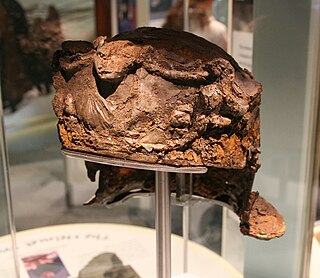 W
WThe Hallaton Helmet is a decorated iron Roman cavalry parade helmet originally covered in a sheet of silver and decorated in places with gold leaf. It was discovered in 2000 near Hallaton, Leicestershire after Ken Wallace, a member of the Hallaton Fieldwork Group, found coins in the area. Further investigation by professional archaeologists from the University of Leicester Archaeological Services discovered that the site appeared to have been used as a large-scale Iron Age shrine. Nine years of conservation and restoration have been undertaken by experts from the British Museum, supported by a Heritage Lottery Fund grant of £650,000. The helmet is now on permanent display at the Harborough Museum in Market Harborough alongside other artefacts from the Hallaton Treasure hoard.
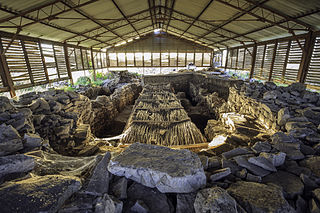 W
WHalmyris was a Roman and Byzantine fort, settlement and naval port, located 2.5 kilometers west of the village of Murighiol at the mouth of the Danube Delta in Romania. It is locally known as the site where the bodies of two Christian saints, Epictet and Astion, were uncovered between 2001 and 2004.
 W
WIaat is a town and municipality located in the Beqaa Valley of Lebanon, famed for its Corinthian column: this is a single column of unknown date, approximately half way between Baalbek and Qasr el Banat, with a cartouche on the 6th drum but no inscription.
 W
WThe Lapis Satricanus, is a yellow stone found in the ruins of the ancient town of Satricum, near Borgo Montello, a village of southern Lazio, dated late 6th to early 5th centuries BC. It was found in 1977 during excavations by C.M. Stibbe. It reads:(?)IEI STETERAI POPLIOSIO VALESIOSIO SVODALES MAMARTEI
 W
WThe Mazor Mausoleum is one of the best preserved Roman buildings in Israel, located in El'ad. The Mausoleum, which is the only Roman era building in Israel to still stand from its foundations to its roof, was built for an important Roman man and his wife in the 3rd century AD. Their identities remain a mystery but one can still see the remnants of two sarcophagi in the mausoleum.
 W
WNikyup is a village in Northern Bulgaria, in Veliko Tarnovo Province, 194 km east of Sofia, Bulgaria's capital. The closest airport is in Gorna Oryahovitsa, 15 kilometers southeast.
 W
WThe Dvojna vrata is a Roman city gate located in Pula, Croatia. It was built during the late 2nd century. The Porta gemina is a double arched gate. It was one of the ten city gates of Pula, standing at the north side of the capitol.
 W
WThe Vyne Ring or the Ring of Silvianus is a gold ring, dating probably from the 4th century AD, discovered in a ploughed field near Silchester, in Hampshire, England, in 1785. Originally the property of a British Roman called Silvianus, it was apparently stolen by a person named Senicianus, upon whom Silvianus called down a curse.
 W
WThe Roman Dam of Pego da Moura is a small buttress dam situated in the municipality of Grândola in the Setúbal District of Portugal.
 W
WThe Roman fish salting factory was a salting factory established on the seafront of Algeciras, southeastern Spain by the Romans. It belonged to the fishing village of San Nicolás, part of what was called Caetaria. A site of archaeological and historical interest, it was declared a Bien de Interés Cultural site on 27 June 2002.
 W
WThe Roman Forum, also known by its Latin name Forum Romanum, is a rectangular forum (plaza) surrounded by the ruins of several important ancient government buildings at the center of the city of Rome. Citizens of the ancient city referred to this space, originally a marketplace, as the Forum Magnum, or simply the Forum.
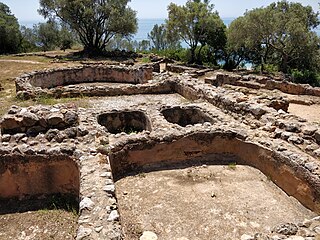 W
WThe Roman ruins of Creiro are situated in the Arrábida Natural Park above Creiro Beach in the Setúbal District of Portugal. They are ruins of a fish-salting factory and Roman baths, dating back to the days when the province of Lusitania formed part of the Roman Empire.
 W
WThe Roman ruins of Tróia is an archaeological site located on the left bank of the River Sado, on the northwest side of the Tróia Peninsula, opposite Setúbal, in the Setúbal District of Portugal. The ruins, which include fish processing facilities, thermal baths, and burial sites are from between the 1st to 6th centuries CE. They have been classified as a Portuguese National Monument since 1910.
 W
WThe Roman ship of Marausa is the wreck of Roman merchant ship from the third century AD which was discovered about 150 metres off the coast from Trapani.
 W
WThe Roman villa of Tourega is in the parish of Nossa Senhora da Tourega in the Évora District of the Alentejo region of Portugal. During Roman occupation of Portugal it was part of the province of Lusitania, situated a few kilometers to the southwest of Civitas Ebora Liberalitas Julia, the modern-day Evora. It was next to the Roman road to Salacia and only five kilometers from the Roman road to Pax Julia, the modern-day Beja. Excavations indicate that it was in use between the mid-first century CE and the end of the fourth century and that, at least in the third century, it belonged to a family of senatorial rank. The Villa, which was primarily used for farming, was classified as a Site of Public Interest in 2012.
 W
WThe Rufus Sita Tombstone is the marker of the grave of Rufus Sita, a Roman soldier from the mid 1st Century AD, found near London Road, Gloucester, in 1824. The stone is approximately 4ft by 3ft in size.
 W
WThe Saepta Julia was a building in the Campus Martius of Rome, where citizens gathered to cast votes. The building was conceived by Julius Caesar and dedicated by Marcus Vipsanius Agrippa in 26 BCE. The building replaced an older structure, called the Ovile, built as a place for the comitia tributa to gather to cast votes. The Saepta Julia can be seen on the Forma Urbis Romae, a map of the city of Rome as it existed in the early 3rd century CE. Part of the original wall of the Saepta Julia can still be seen right next to the Pantheon.
 W
WJanet Stephens is a hairstyle archaeologist who studies historical hairstyles, aiming to prove that they were not done with wigs, as commonly believed, but with the person's own hair.
 W
WThe Tangendorf disc brooch is an Iron Age fibula from the 3rd century AD, which was dug up in 1930 from the sand of a Bronze Age tumulus near Tangendorf, Toppenstedt, Harburg, Lower Saxony, Germany. The front of the elaborately crafted garment fibula is decorated with a rear-facing four-legged animal, probably a dog or a deer. It is one of Harburg's most important finds from the period of the Roman Empire, and is in the permanent exhibition of the Archaeological Museum Hamburg in Harburg, Hamburg.
 W
WThe Temple of Claudius or Temple of the Deified Claudius was a large octastyle temple built in Camulodunum, the modern Colchester in Essex. The main building was constructed between 49 and 60 CE, although additions were built throughout the Roman-era. Today it forms the base of the Norman Colchester Castle. It is one of at least eight Roman-era pagan temples in Colchester, and was the largest temple of its kind in Roman Britain; its current remains potentially represent the earliest existing Roman stonework in the country.
 W
WThe "Temple of Janus" is a Romano-Celtic religious structure located in Autun, Saône-et-Loire, France, to the North-West of the ancient city of Augustodunum.
 W
WTerme Taurine, also known as the Taurine Baths, is a former Roman bathhouse complex located outside of the Italian city of Civitavecchia. The site contains ruins dating to both Republican and Imperial era Rome, with the oldest structures at Terme Taurine having been built in the first century BC. In modern era, the baths are considered an archaeological park.
 W
WThe University Museum A Domus do Mitreo is a museum center built on the old site of the Pazo de Montenegro and annexed buildings, next to the Roman walls of Lugo. The Museum is called Domus do Mitreo because when archaeological surveys were carried out, prior to the construction of the new building, the remains of a domus appeared. This domus, during the Lower Roman Empire, was partially reformed to build a private building intended for use as a Mithraeum. The historical importance of the archaeological remains discovered led to revise the architectural project initially planned to preserve and incorporate them into the new building.
 W
WVerulamium was a town in Roman Britain. It was sited southwest of the modern city of St Albans in Hertfordshire, England. A large portion of the Roman city remains unexcavated, being now park and agricultural land, though much has been built upon. The ancient Watling Street passed through the city. Much of the site and its environs is now classed as a scheduled monument.
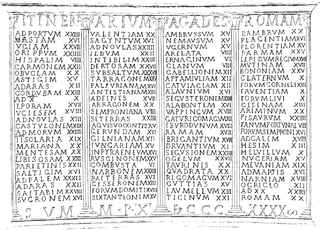 W
WThe Vicarello Cups are four silver cups discovered in 1852 near the baths of Aquae Apollinares, at Vicarello, Italy, near Lake Bracciano.
 W
WThe Witcham Gravel helmet is a Roman auxiliary cavalry helmet from the first century AD. Only the decorative copper alloy casing remains; an iron core originally fit under the casing, but has now corroded away. The cap, neck guard, and cheek guards were originally tinned, giving the appearance of a silver helmet encircled by a gold band. The helmet's distinctive feature is the presence of three hollow bosses, out of an original six, that decorate the exterior. No other Roman helmet is known to have such a feature. They may be a decorative embellishment influenced by Etruscan helmets from the sixth century BC, which had similar, lead-filled bosses, that would have deflected blades.